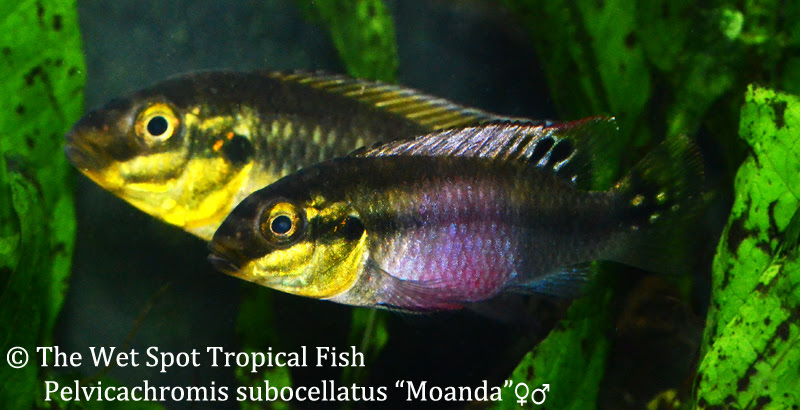via The Wet Spot
Pelvicachromis subocellatus ‘Moanda’
This is a “salty” dwarf cichlid hailing from slow-moving streams in coastal regions of West Africa, it is found in both fresh and brackish environments in the Congo Basin. Reaching just over 3 inches in length, “Moanda” males have dark “ocellated” markings on their neutral-colored bodies and exhibit bright blue patterned fins. Females are slightly smaller in stature and have dark bodies with bright pink bellies, yellow faces with dark stripes, and blue dorsal fins.
Husbandry
Timid by nature, these “Kribs” are happiest in tanks equipped with lots of cover like PVC pipe, rock piles, clay pots, tall and floating plants, and driftwood. Tank substrate should be smooth, fine gravel or sand, as these dwarf cichlids excavate pits when spawning. Breeding pairs may be somewhat territorial and can be kept as single pairs alongside small characins, Barbs, Danios, Gouramis, and Corydoras. Natural diets consist mainly of small invertebrates, and they should be fed regular live and frozen meals alongside high-quality dried products. Waters should be maintained with temperatures of 72 to 79°F, pH between 5.5 and 7.5, and hardness of 90 to 356 ppm.
Tanganyika’s Cichlid Flock Origin
While the Congo isn’t necessarily known for its cichlids, the river was a point of origin for 7 of the 10 Tanganyikan cichlid families. The sheer range of the basin’s ecology has led to numerous unique species that should never be swept downstream, and in our opinion, make great crowning jewels of thoughtfully orchestrated aquascapes.







Trackbacks/Pingbacks